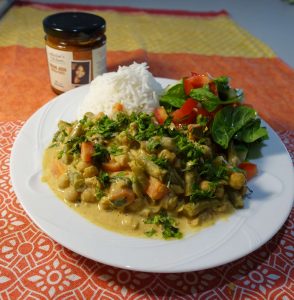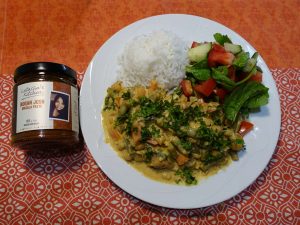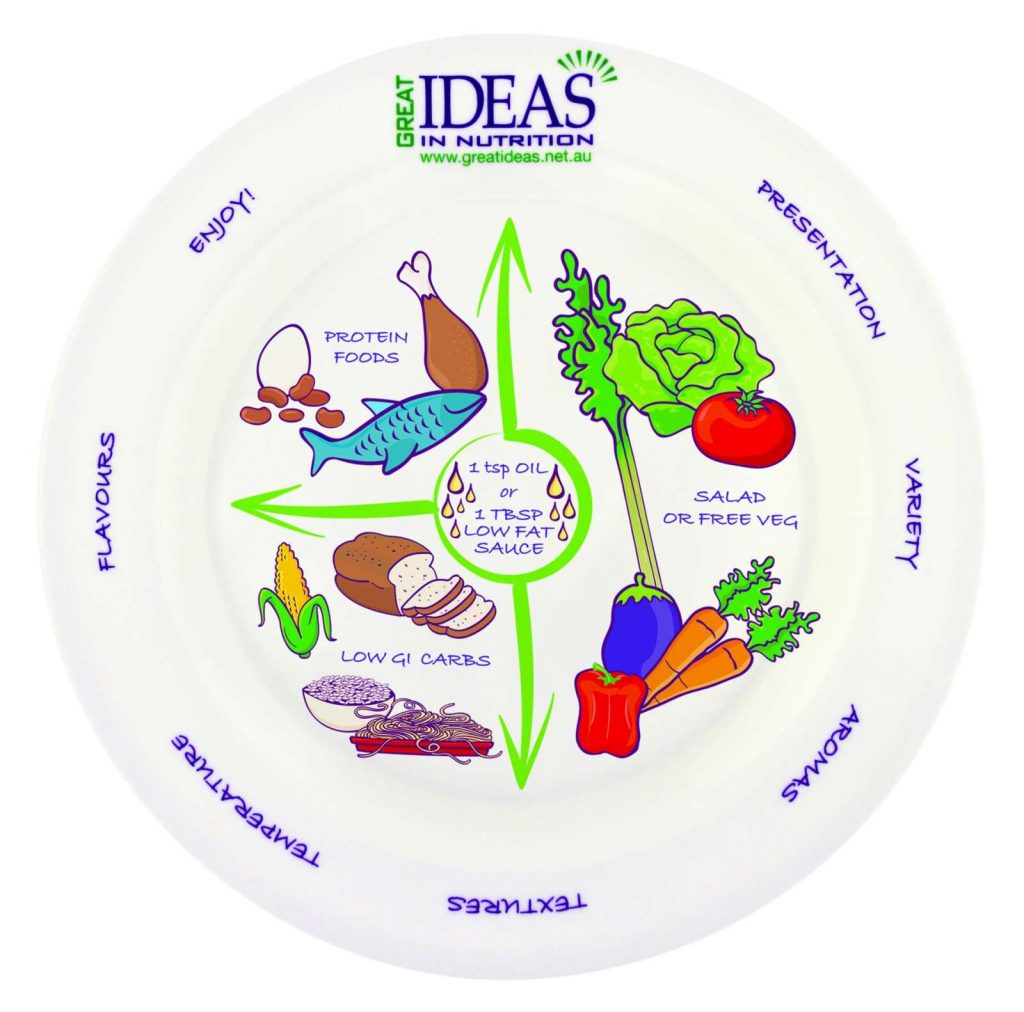Part 3: The Portion Plate recipes and guide
My Portion Plate recipes
- I have included in the recipe pages a range of everyday recipes that I make using Latasha’s Kitchen Concentrated Indian and Asian Curry Pastes and Condiments.
- The recipes are in general easy to make, relatively quick to make and include at their core a limited number of ingredients with some optional extra ingredients if you have them at hand. These dishes can be eaten every day and your health will benefit the most if they are consumed regularly in portions shown in the portion plate photos.
- The recipes are provided with a close-up image and a portion plating image and description as recommended for great health so you see how it all works.
- An example is Delicious Chick Pea and Veggie curry made with Latasha’s Kitchen Rogan Josh Masala Paste shown below.


- Portion plating
- ¼ plate protein-rich food – provided by the chickpeas in the curry and the yoghurt
- ¼ plate low GI carbohydrate -1 cup of cooked rice
- ½ plate vegetables – provided by the vegetable-rich curry and the salad
The Portion Plate in detail
Here are the KEY points
- Use a modest sized plate for your meals , about 20 cm is great with a few cm’s of border around the side.
- Consistently eating lunch and dinner with these food proportions allows improvements in the health.
- Focus on proportions of food on the plate. Match your meals to the proportion pictures in the guide. Follow the 1)2)3) below.
- Small serves of low glycemic index (low GI) carbohydrate-rich foods
- Small serves of protein-rich foods (animal or plant proteins)
- Large serves of low-carbohydrate veggies , these are the fill up food group so enjoy in abundance!

The Portion Perfection Plate reproduced with permission Great Ideas in Nutrition www.greatideas.net.au
These are the proportions of ingredients to use in meals. You can cook them into tasty curries, stir fries, casseroles, oven bakes, salads……Latashas’s products make this easy to do, have a look at some of my everyday recipes.
Check out this great downloadable guide from the Baker IDI to see what we’re talking about. The guide includes terrific meal images that really illustrate the portion plate idea.
Here’s some more detail about our 1,2,3 steps:
1) Small serves of low glycemic index (Low GI) carbohydrates – what on earth does this mean?
- The Glycemic index of a food refers to the rate at which the food is broken down by digestion to it’s component glucose units and how quickly these glucose units are absorbed from the gut into the blood stream. The amount and type of carbohydrate you eat will affect your blood sugar level.
- Eating the quickly digested carbohydrate-rich foods (High GI) results in the blood sugar level going up quickly and eating the slower digested ones (Low GI) will cause a smaller blood sugar rise that the body can more easily handle.
- Cutting carbohydrates out is not a good idea as many carbohydrates provide fibre , vitamins and minerals that aid health and lower disease risk so instead choose small portions of the slowly digesting choices below will keep your body happy on all fronts.
- Low GI carbohydrate foods include – Basmati or Doongara rice, pasta, dense/heavy grain bread, wholemeal pita bread, Carisma Potatoes, Sweet Potato, Sweet Corn, Quinoa, Israeli cous cous(the big one), Buckwheat, Barley and Oats. Serve sizes from the Portion Plate guide are typically 2/3 – 1 cup of the cooked item or 2 thin slices of low GI bread/ 1 medium pita or 1 medium potato or equivalent sweet potato/ corn.
2) Small serves of meat and meat alternatives for protein
Choose one of the following items or two smaller portions if you want to use two items eg. meat and legumes for example.
- Animal-based protein choices include – 120 gm of cooked meats(red and white) such as beef, lamb, pork, kangaroo, turkey OR 150 gm cooked fish OR 2 eggs OR 1 cup of milk or calcium fortified substitute, 40 gm cheese, 150gm yoghurt, 100gm paneer/ ricotta
- Plant-based protein. We all hear that we need more meals based on this so use the following with Latasha’s products for some tasty meals. Plant-based protein choices include – 150 gms cooked legumes, 150gm tofu or 100gm tempeh, unsalted 50 gm seeds and nuts and nut butters, OR 125 gm quorn mince
- TIP: Legumes – For an animal food alternative try canned legumes. They are ready to use and need little cooking. The bagged lentils/split peas for protein are also quick to cook with the lentils (red or brown) taking 20 mins or thereabouts.
3) Large serves of low-carbohydrate veggies to fill up on, permission to eat in abundance.
- Include the low-carb. veggies in the main dish AND as a side dish to get the amount needed for great health.
Examples include: Asian Greens-many types, Asparagus, Beans, Beetroot, Broccoli, Broccolini, Brussels Sprouts, Cabbage, Capsicum, Carrot, Cauliflower, Celery, Cucumber, Eggplant, Fennel, Garlic, Green Leaves/Lettuce-many types, Herbs, Mushrooms, Okra, Onion, Peas, Pumpkin, Radish, Snow Peas, Spinach, Sprouts, Squash, Swede, Tomato, Turnip, Zucchini.
Use them fresh, frozen or tinned – whatever suits your time frame.
- for fresh;
- chop them yourself or buy pre-chopped if ultra-busy
- cooked or raw/salad or both can be used at the meal.
- leading by example is a great way to encourage the family to eat more vegetables. Prepare them for yourself at meals, especially the easy ones shown below, so you don’t miss out.
- The easiest fresh veggies to deal with take a minute or two only to prepare for eating or cooking and include cherry tomatoes, bagged greens or coleslaw mix (great for stir-fries), cucumber, sugar snap peas/snow peas, bean sprouts, capsicum and mushrooms.Others take a little longer but a quick wash and a rough chop (precision unnecessary) is often all that is needed eg. Asian greens, onion, eggplant, carrots, pumpkin, broccoli and cauliflower. Pre-chopped veggies can help us meet the veggie goals.
- for frozen
- many types are available and ready to use. Frozen vegetables are very nutritious as they are snap frozen when just picked. I prefer Australian or New Zealand sourced frozen vegies where possible. Frozen spinach, chopped onions for a ‘’hurry curry’’, edamame for salads, individual packs of carrot/cauliflower/broccoli mix for example.
- for tinned
- tomatoes are probably the most useful of these as most other vegetables that are tinned for ease-of-use taste better in the frozen form, our other easy-to-use alternative.

Join #latashaskitcheners
Join Latasha's personal mailing list for delicious recipes, exclusive promotions and behind the scenes update direct to your inbox.